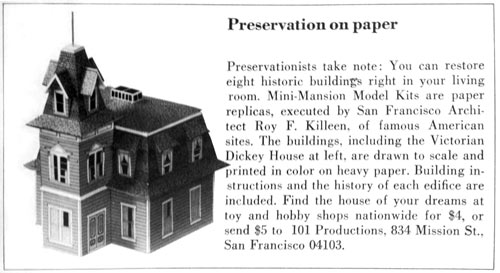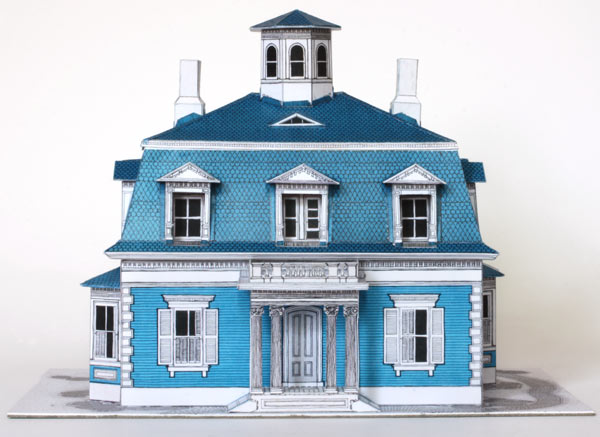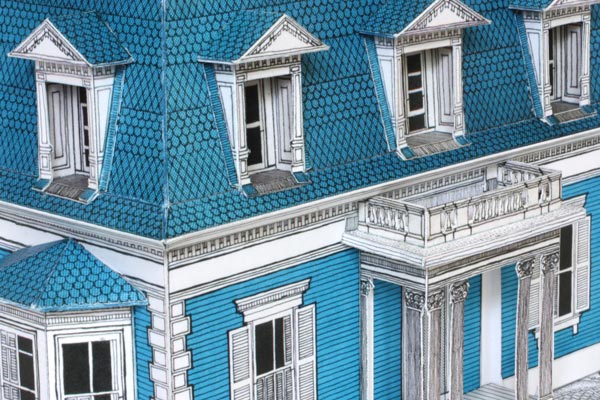101 Productions
In 1968, San Francisco wife-and husband Jacqueline Killeen and Roy Killeen quit their day jobs in arts management and architecture to publish a restaurant guide 101 Nights in California. The book title and the new publishing company's name, 101 Productions, evoked the peripatetic exoticism of the Arabian Nights and the California spirit of Highway 101. Jacqueline was the writer and editor, while Roy was the designer and illustrator, as well as traveling salesman with a supply of book samples in the back of the car.
Roy Killeen was born in St. Louis in 1930. After receiving an architecture degree from Washington University, he enlisted in the Navy and served in Hawaii, where he met Jacqueline Traylor. The couple married in 1956 and moved to suburban Webster Groves, MO where Roy started working for an architecture firm and Jacqueline worked as a magazine editor. By 1961 they had moved to San Francisco where Roy worked for the large architecture firm Anshen & Allen and remodeled old Victorian houses on the side, while Jackie worked as director of publicity for the San Francisco Art Institute.
The 101 Nights restaurant guide was an immediate hit, and in a few years the company was able to move out of the couple's garage into a real office. 101 Productions became well-known for its affordable paperback cookbooks of California cuisine and travel guidebooks to West Coast inns and restaurants, but the second additions to the 101 catalog after the 101 Nights book were the first "Mini-Mansion Model Kit" paper cutouts designed by Roy. These architectural scale models featured some unique California buildings, but the subjects also ranged far across the United States. Despite the series name, only four of the later kits represent houses that could be considered mansions.

Mini-mansion product review in House Beautiful, 1978
It's not immediately obvious how Roy chose the subjects for his kits. They are generally stand-alone structures with picturesque towers or cupolas. Several of the kits were prepared with the assistance of local historical societies, which may have been an inspiration for chosing the subjects and a venue for selling the models. The Old Plaza Firehouse in the restored historic Pueblo of Los Angeles opened as a firefighting museum in 1960. The Dickey House (now known as the Lyford House) in Tiburon had a unique role in the preservation of Richardson Bay by the National Audubon Society in the 1950s. The John Muir House in Martinez, home of the national parks preservationist and founder of the Sierra Club, opened to the public as a National Historic Site in 1964. The last kit in the series, The Colonial Homes of the Revolution, was obviously prepared for the upcoming Bicentennial, but the other models represent less-famous historical subjects.

Detail of Sheet no. 2 for Captain Penniman House model
The artwork for the models is attractive hand-drawn pen and ink, with flat colors and occasional halftone shading. As shown in the closeup above, the parts are crammed together closely, with tiny notes indicating folds and reverse folds. The numbers indicate the assembly order but are not assigned to the parts themselves: Instead each individual tab gets its own number or subnumber, which matches a corresponding place to glue it, an unusual and sometimes confusing numbering system. Each sheet uses one or two spot colors which are not necessarily related to the colors of the real building. For this reason the completed model looks more like an architectural illustration sprung to life than a photo-realistic scale representation. Although they are designed to various scales, the finished models are fairly large, at least 12" tall.

Captain Penniman House model (1972)
The kits are packaged in a shrink-wrapped packages about 10-1/2" x 15" and include a cover sheet, four to eight cardstock art sheets, a heavy pasteboard base, a thin sheet with typewritten instructions and exploded diagram, and sometimes a wooden skewer to use as a flagpole. The models originally sold for $4.00 or $4.50 each. Several of them were reprinted more than once with slightly different cover sheets at each reprinting.

Closeup of Captain Penniman House dormer windows
101 Productions published over one hundred thirty book titles up until the early 1990s, in addition to the ten Mini-Mansions Kits from the early 1970s. Jacqueline passed away in 1995. Several years later Roy moved back to St. Louis, where he passed away in June 2009.
A complete list of published paper model work by 101 Productions:
References
Roy Killeen Obituary, St. Louis Post-Dispatch, Jun 21, 2009
Jacqueline Killeen Obituary, San Francisco Chronicle, Apr 26, 1995
"The Cook Concoted a Book," Joan McKinney, San Francisco Chronicle, Dec 4, 1969
"Smaller version of cookbooks gaining popularity," William Rice, Washington Post, Nov 2, 1975
"'101' cookbooks are ahead of the pack," Joanne Will, Chicago Tribune, Jan 24, 1980